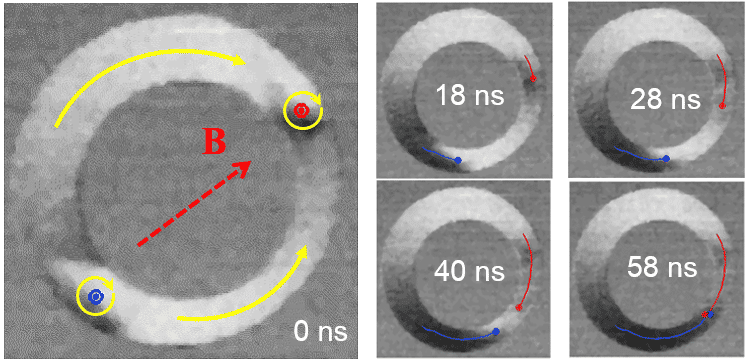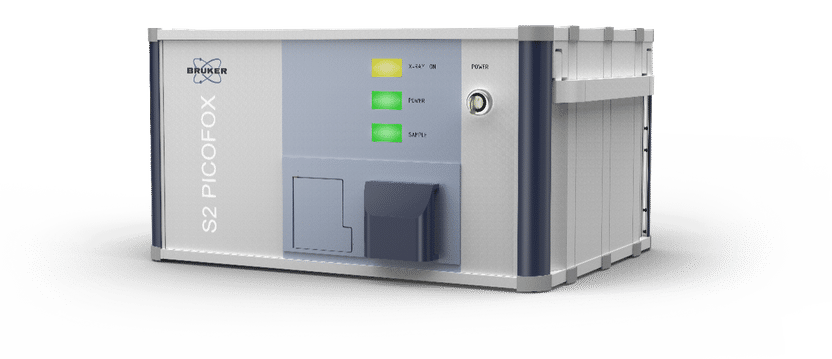Green IT: New switching process in non-volatile spintronics devices
Physicists achieved a robust and reliable magnetization switching process by domain wall displacement without any applied fields. The effect is observed in tiny asymmetric permalloy rings and may pave the way to extremely efficient new memory devices.

A magnetic field pulse switches the initial vortex state to “onion state” with two walls. In the subsequent magnetic snapshots the domain wall motion is shown. After 58 ns both walls meet and annihilate, thus completing the switching process into the opposite sense of rotation.
HZB
To construct magnetic memories, elements with two stable magnetization states are needed. Promising candidate for such magnetic elements are tiny rings, typically of the order of few micrometers, with clockwise or counterclockwise magnetization as the two states. Unfortunately, switching between those two states directly requires a circular magnetic field which is not easy to achieve.
Switching in asymmetric nanorings
But this problem can be solved, as demonstrated by a team of scientists from several institutions in Germany including Helmholtz-Zentrum Berlin: If the hole in the ring is slightly displaced, thus making the ring thinner on one side, a simple, uniaxial magnetic field pulse of some nanoseconds duration can switches between the two possible “vortex states” used for data storage (clockwise and counterclockwise).
Short magnetic field pulse is sufficient
The scientists recorded the time evolution of the magnetization dynamics of the device at the Maxymus-Beamline at BESSY II employing time-resolved x-ray microscopy during and after the short magnetic field pulse was applied. They observed how the magnetic field pulse leads in a first step to an intermediate “onion state” in the ring. This state is characterized by two domain walls, where different magnetization zones meet each other. After the external field pulse has vanished, these domain walls move towards each other and annihilate, which results in a stable opposite magnetization of the ring “vortex state”.
Very fast process for spintronics
“Our measurements show domain wall automotion with an average velocity of about 60 m/s. This is very fast for spintronic devices at zero applied field”, Dr. Mohamad-Assaad Mawass, lead author of the publication in Physical Review Applied, points out. Mawass has worked on these experiments already for his PhD at Johannes Gutenberg University Mainz (group of Prof. Kläui) in a joined project with Max Planck Institute for intelligent system at Stuttgart (Schütz-Department). He then continued his research as a postdoc research Scientist at X-PEEM beamline at HZB.
Details of domain wall motion observed
Another observation concerns the effect of the detailed topological nature of the walls in the annihilation process. According to the results, this effect influence the dynamics only on a local scale where walls experience an attractive or repulsive interaction once they get very close to each other without inhibiting the annihilation of walls through automotion. “The domain wall inertia and the stored energy, in the system, allows the walls to overcome both the local extrinsic pinning and the topological repulsion between DWs carrying the same winding number” said Mawass. “We believe to have identified a robust and reliable switching process by domain wall automotion in ferromagnetic rings”, Mawass states. “This could pave the way for further optimization of these devices.”
Original publication
Most read news
Original publication
"Switching by domain wall automotion in asymmetric ferromagnetic rings”; Mohamad-Assaad Mawass, Kornel Richter, Andre Bisig, Robert M. Reeve, Benjamin Krüger, Markus Weigand, Andrea Krone, Hermann Stoll, Florian Kronast, Gisela Schütz, and Mathias Kläui; Physical Review Applied; 2017
Organizations
Other news from the department science

Get the chemical industry in your inbox
By submitting this form you agree that LUMITOS AG will send you the newsletter(s) selected above by email. Your data will not be passed on to third parties. Your data will be stored and processed in accordance with our data protection regulations. LUMITOS may contact you by email for the purpose of advertising or market and opinion surveys. You can revoke your consent at any time without giving reasons to LUMITOS AG, Ernst-Augustin-Str. 2, 12489 Berlin, Germany or by e-mail at revoke@lumitos.com with effect for the future. In addition, each email contains a link to unsubscribe from the corresponding newsletter.
Most read news
More news from our other portals
Last viewed contents
Schaefer-Bergmann_diffraction
Cossee-Arlman_mechanism

S2 PICOFOX | Total reflection x-ray fluorescence spectrometers | Bruker
Heptad_repeat




























































